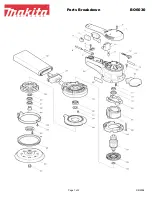
7
2. SPECIFICATIONS
Input power..............................................................……900 W
R.P.M. (no load)………………............................….3,500-6,500
Orbit diameter................…..........................................5.5 mm
Sanding disc diameter..........................................….150 mm
Weight...............................................................................2.6 Kg
Weighted equivalent continuous
acoustic pressure level A..................................................89 dBA
Acoustic power level A...................................................100 dBA
Uncertainty...................................................................K = 3 dbA
Wear ear protection!
Vibration total values.................................................a
h
: 5m/s
2
Uncertainty....................................................................K: 1.5 m/s
2
3. STANDARD EQUIPMENT
The box contains the following items:
1. Velcro soft sandind plate 8845485
2. Sanding disc gr.120
3. ALLEN key e/c: 6 mm.
4. Dust collection bag assembly
5. Plate protector
6. Operating instructions and miscellaneous docu-
mentation
4. OPTIONAL ACCESSORIES AND TOOLS
1. Adhesive soft sanding plate ref. 8845487
2. Adhesive soft sanding plate ref. 8846367
3. Velcro soft sanding plate ref. 8846366
4. Standard dust collector attachment 2.25 m ref. 6446073
5. APPLICATIONS
Especially indicated for car body repair work and the
sanding and polishing of sheet metal. It may also be
used for sanding wood surfaces when the appropriate
sandpaper is fitted, giving a high-quality finish.
Its two movements (rotary and orbital) means smoothing
or finishing operations can be done quickly, leaving a
completely smooth, scratch-free surface.
Its specifications make it ideal for delicate sanding with
varnishing jobs.
The sander is fitted with a sanding dust collection system
and a duct collection bag.
5.1. WORKING WITH PLATE PROTECTOR
Gently perform the opening of the
protector in the assembly operation and
disassembly to avoid breakage of the
same.
The plate protector (L Fig. 1 and 2), is designed to prevent
the plate (A) from touching the lateral work surface and
causing a rebound in the machine, it also allows to extend
the life of the plate avoiding continuous and repeated
shocks. The assembly is done by anchoring it from the
left to the right, matching the wicks (M Fig. 2) in the
housings (N Fig. 2) of the hood. For its extraction, the
reverse operation must be carried out.
5.2. WORKING WITH SOFT PLATE
The soft plate (A) has 6 equidistant marks (O, Fig. 2)
distributed on the surface that allow visualizing the
machine control to perform orbital machine work. To
perform orbital type work, you must combine the speed
regulation on position "0" (D, Fig. 2) and the pressure of
the machine exerted on the surface to be worked. It is
perceived when the machine is sanding in orbital mode
when checking that the marks (O) on the plate are visually
frozen (stroboscopic effect), roughing, depending on the
material to be worked.
6. PREPARING THE MACHINE
Place the sanding disc on plate "A" (Fig. 1) and match
up its holes with those on the plate.
If the plate has an adhesive base, carefully remove the
protective paper on the disc to prevent dirt coming into
contact with the adhesive part and exert pressure on
the disc until it is well attached.
Before starting work, check that the whole surface of
the disc is well stuck to the plate.
Should the discs not have suction holes, these may be
made by copying those on the plate.
7. STARTING UP
Before plugging in the machine, ensure that the power
supply voltage is the same as that stated on the machine
specifications plate. Hold the machine firmly and push
switch "B" (Fig. 1) forward to the on position. To stop
the machine, simply press the back of the switch and it
will return to the off position.
Place the machine over the surface to be sanded and
work the surface until the required finish is obtained.
You do not need to exert much pressure on the machine
while working as the best finishes are obtained using
just the weight of the machine itself.
The electronically regulated speed allows you to work
at the most appropriate speed for each surface and
sandpaper. This is particularly useful for heat-sensitive
surfaces, which require lower sanding speeds. To adjust
the speed, turn button "D" to the required working
speed (Fig. 2).








































